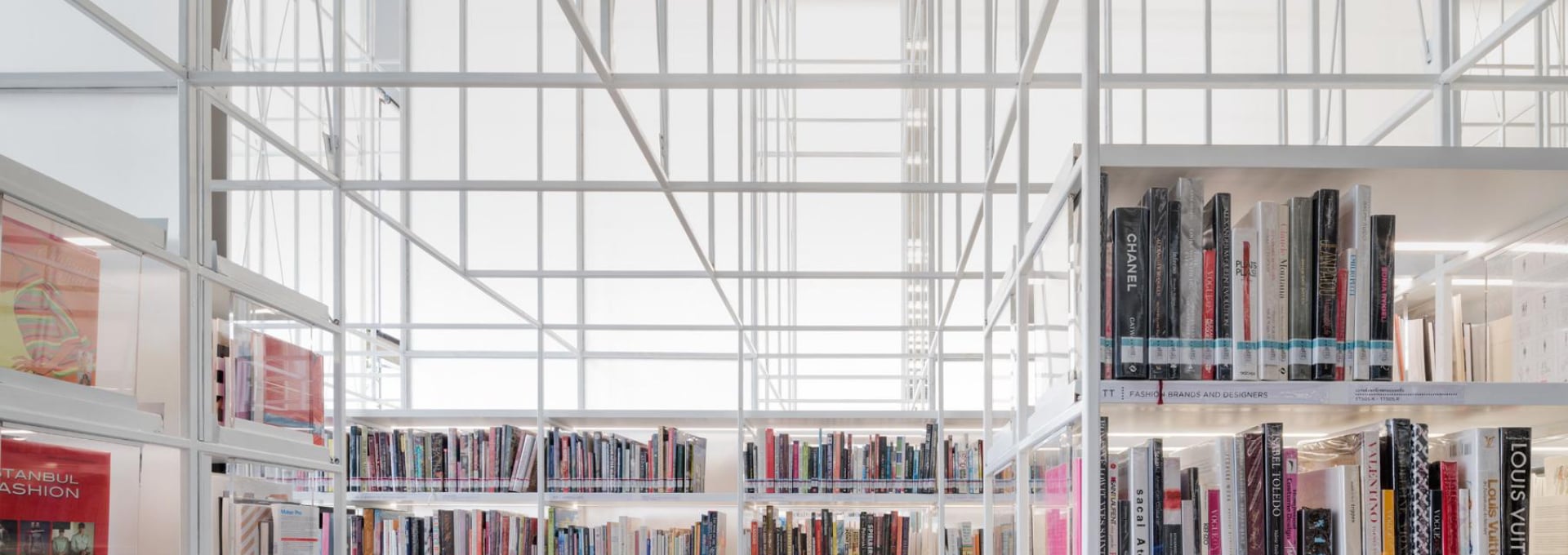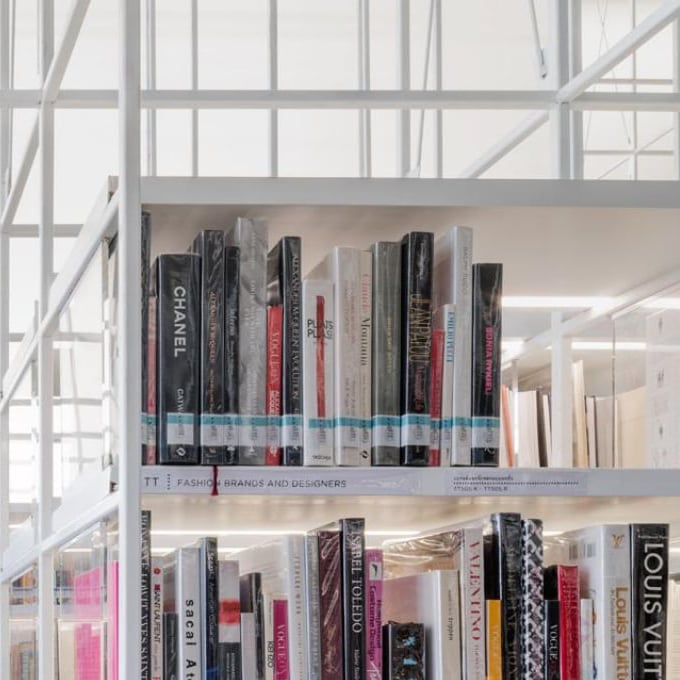Introducing concepts for the development of 10 UCCN creative cities
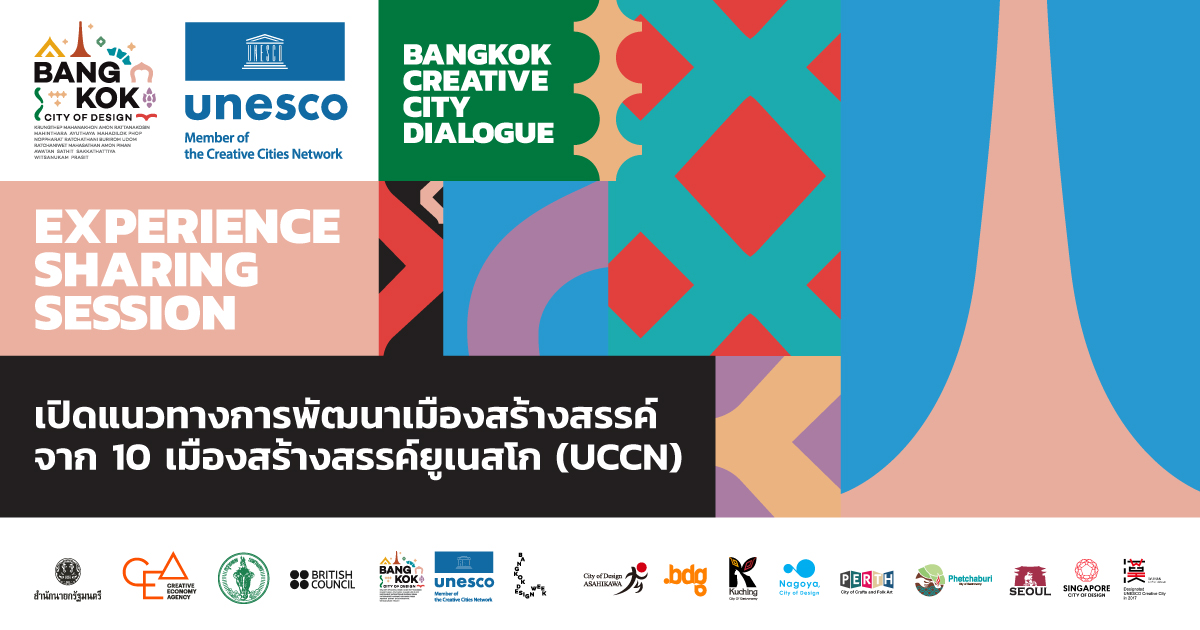
This is to provide a summary of the discussion held during the experience sharing session under the theme “Becoming and creating impact as a creative city” at the Bangkok Creative City Dialogue held on February 10, 2023. The session began with a discussion on concepts for development and the positive impact of becoming a creative city, addressed by representatives from 10 cities in eight countries in the Asian and European regions, at TCDC, Bangkok, between 9.00 - 12.00 hrs.
Participants joined together to seek inspiration to develop a creative city from the UNESCO Creative Cities Network (UCCN) of 10 cities located in the Asian and European regions. They shared ideas and experiences to promote and elevate the importance of these cities. The event aimed to unveil the capability and potential of Bangkok, one of the UCCN members, as a host city as well as promote on-going cooperation through different campaigns and projects. This gathering also helped members explore the possibility of future cooperation within the network.
The 10 cities of the UNESCO Creative Cities Network are from three categories: Design, Crafts and Folk Art, and Gastronomy, comprising
1. Asahikawa City of Design (Japan)
2. Bandung City of Design (Indonesia)
3. Bangkok City of Design (Thailand)
4. Kuching City of Gastronomy (Malaysia)
5. Nagoya City of Design (Japan)
6. Perth City of Crafts and Folk Art (Scotland, United Kingdom)
7. Phetchaburi City of Gastronomy (Thailand)
8. Seoul City of Design (South Korea)
9. Singapore City of Design (Singapore)
10. Wuhan City of Design (China)
1. Asahikawa City of Design (Japan)
Topic: “Diverse Ways to Realize Design City: The Challenge from Northern Hokkaido” by a representative from Asahikawa City of Design

“Asahikawa has continually expanded under the concept “Forest of Design”. In 2019, Asahikawa was named the UCCN city of design, or Asahikawa City of Design. The potential and capabilities of its people, nature, and culture are promoted using designs through organized projects and activities revolving around the concept of the forest to nurture seedlings that will grow into larger trees of happiness and lush green forests.
The first project, “History Tree,” reflects the heart and soul of the city’s pioneers since the establishment of Asahikawa some 100 years ago. The city has undergone various changes through the years. Asahikawa is well-known for its forestry and industrial trees, and therefore, the furniture business has become the backbone of the local people. A furniture design contest is organized every year. Since Asahikawa offers four seasons in a year, the city’s natural surroundings and landscape are simply amazing, appropriately responding to the Nature Tree concept of development and prompting many organized creative-related activities. With the Regional Tree concept, Asahikawa partnered with neighboring cities, expanding the cooperation into the Asahikawa region, offering modern facilities, amenities, and beautiful garden areas covering 28 percent of the city’s area.
In response to the Education Tree concept, certain city areas have been allocated for educational and learning purposes. Innovative designs at the city center, organization buildings, exhibition areas, and activities were carried out for city residents and students. Surveys showed that visitors to these areas were satisfied with what had been arranged. This concept aims to raise greater awareness of UN sustainable development goals, or SDGs, designs, and UCCN.”
Ryoju Hamada
Senior Advisor at Asahikawa Focal Point
Asahikawa City of Design
Professor, Asahikawa Kosen College, Japan National Institute of Technology
2. Bandung City of Design (Indonesia)
Topic: “From Bottom-Up Initiatives to Community Resilience” by a representative from Bandung City of Design (Indonesia)

“Bandung is located west of Indonesia and has a population of 50 million people. Therefore, in 2015, when Bandung was named the UCCN City of Design or Bandung City of Design, we focused our attention on possible impacts that may occur in our city. We decided to establish a bottom-up work structure, starting with people elevating to policy positions.
Bandung spearheaded many projects and activities in support of its creative city position, including the Design Thinking for Government project, which is an organized workshop of design-related concepts between the government and public sectors to find ways to solve problems that occurred in the city. Areas were allocated for the public to showcase their creative works and to act as a platform to drive many community projects forward, including the Bandung Design Biennale 2017.
The creative design of the city’s biodiversity and 10 working principles have been established to promote a creative city, along with the development of a creative economy index. The 10-year (2020 - 2030) human resource development programs are in place, especially for the young generation, and were distributed at the Bali Creative Economy Roadmap 2022. In 2023, activities will be organized to promote Bandung, including The Future of Creative Economy and Bandung Design Biennales 2023, to ensure an on-going development in other aspects of interest.”
Dwinita Larasati
Expert Board
Bandung Creative Economy Committee
3. Bangkok City of Design (Thailand)
Topic: “Transforming Bangkok with Design and Creativity” by a representative from Bangkok City of Design
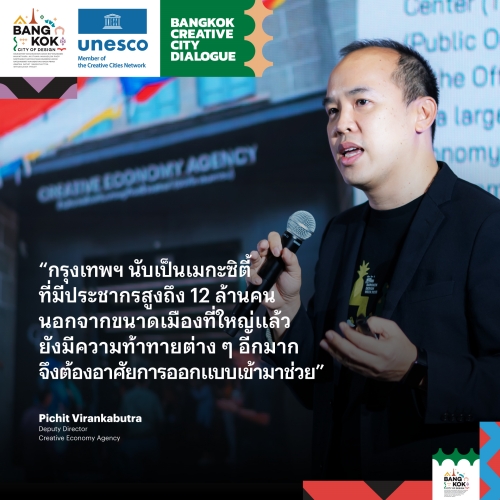
“Bangkok is a megacity full of challenges in so many dimensions, which requires designs to help drive changes and development, while the use of existing resources to make Bangkok even more attractive for living, investment, and travel is essential. This effort is in accordance with the United Nations’ sustainable development goal.
Designs are divided into different elements. Designing the City: Bangkok has continued to work to develop and solve the city’s problems through the initiation of various schemes, such as improving the Klong Ong Ang area, which has become more attractive and helps generate economic value for Bangkok. Designing Communities: Area tests were conducted to promote community living quality, such as public areas and linking green areas together. Designing Wealth: Thailand is home to some one million designers, and over half of them reside in Bangkok. We are therefore trying to utilize the skills and experiences of those designers to drive innovative and sustainable businesses.
Designing a Green City: Bangkok has placed a strong emphasis on developing green areas, which is the main reason that there are more public parks and projects to help reduce pollution from the electric public transportation system. Designing of Branding: Many events and activities have been organized to showcase the works of Thai designers, such as the Bangkok Design Week under the umbrella of Bangkok City of Design. Bangkok Design Week 2023 is organized for six consecutive years. Each year, the actual works are exhibited, such as the bus stop design with the original design displayed at Bangkok Design Week, which has been put up for use at over 1,000 locations. There was also a light and sound event to create accessibility and opportunity for those less favorable areas in order to create new travel spots.
I am pleased to announce that CEA has compiled a Creative City Index for policymakers, creators, travelers, and communities. It started with five key cities and has now expanded to cover 33 cities through the Thailand Creative District Network, or TCDN.”
Pichit Virankabutra
Deputy Director
Creative Economy Agency
4. Kuching City of Gastronomy (Malaysia)
Topic: “Community Building to Create Impact as a Creative City” by a representative from Kuching City of Gastronomy
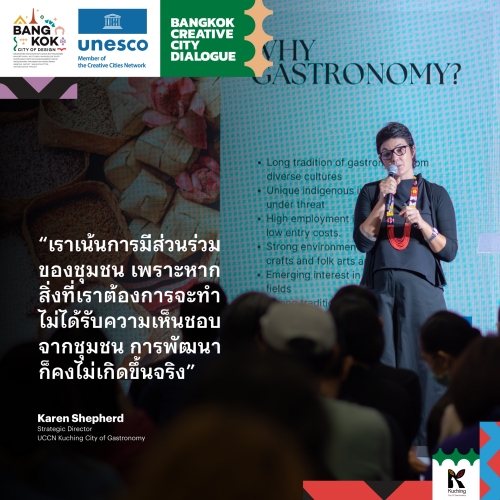
“Kuching is the capital city with the highest population density of Sarawak State, Malaysia. The city, established in 1820, is well-known as the city of trade, cultural exchange, and diverse nationalities. For these reasons, Kuching has a wide variety of food cultures and was named Kuching City of Gastronomy by UNESCO in 2021.
There are many challenges faced by those involved in pushing forward the creative city of gastronomy, where strong support and necessary assistance from those involved are needed. This is not limited to culture but also expands to cover issues related to agriculture, for example, the passing on of local cultivation wisdom to obtain quality ingredients and unique tastes to the next generation. In the next four years, we aim to become a creative hub for gastronomy, building confidence for our partners and stakeholders while creating greater awareness among the people in our city. Our work structure will be different from Bandung’s top-down style. We will focus more on community engagement and solving city problems through organized activities where people living in the community and those in the food industry can share their ideas and thoughts. Experts from around the world are invited to share their knowledge and skills.
The most important element is to ensure that those involved are on the same level of understanding, share the same goal, and work in the same direction using suitable creative tools and ideas. Most of all, we must adopt the right form of top-down work model.”
Karen Shepherd
Strategic Director
UCCN Kuching City of Gastronomy
5. Nagoya City of Design (Japan)
Topic: “Streaming Heritage | Between the Plateaus and the Sea” by a representative from Nagoya City of Design
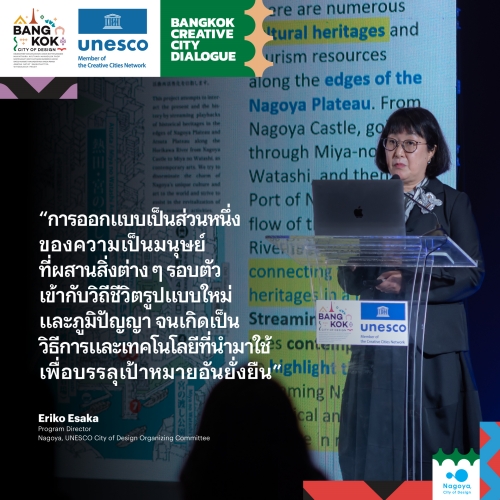
“Nagoya has a population of 2.3 million; it is densely populated and the third largest city in Japan. In 2008, Nagoya was named the City of Design by UNESCO (UCCN – Nagoya City of Design) under three main objectives: nurturing the new generation, promoting environmental preservation, and building a strong cultural network with the existing UCCN. The 2012 “Granag Project” is a good example of a campaign that corresponds well with the city's objective, where students from Granag, Austria, and those of Nagoya have the opportunity to meet and exchange knowledge of designs.
As for the human resources and social development plan for the city of design, we focus on the inheritance of local wisdom and the development of cultural assets. This is the concept behind the setting up of the Streaming Heritage project, which showcases arts and culture, a combination of history and contemporary arts, organized seminars and discussion sessions with experts to exchange knowledge, as well as performances combined with technology to stimulate social and economic activities.
The Streaming Heritage event takes center stage amid a small river that flows through Nagoya. In the old days, this river was of great importance for trade and transportation. This fact began to fade from people’s memories over time. This project will help bring back the importance of this river. A variety of works are showcased at this event, including ancient arts, light and sound, and musical animation. In 2022, the city has expanded its cooperation at the international level, including art projects with Australia after the COVID-19 outbreak eases.”
Eriko Esaka
Program Director
Nagoya, UNESCO City of Design Organizing Committee
6. Perth City of Crafts and Folk Art (Scotland, United Kingdom)
Topic: “Perspectives from Perth and Dundee, UK” by a representative from Perth City of Crafts and Folk Art

“Perth is a small town located in Scotland with a population of 15,000 people. Perth has a beautiful countryside and was named the city of crafts and folk art (UCCN – Perth City of Crafts and Folk Art) in 2021. For Perth, crafts are not limited to local crafts or embroidery but also cover handicrafts of various types, arts, and local beverages. The crafts of Perth therefore strongly reflect the people’s way of life and the town's long history of trade and commerce. Perth is also famous for its culture and tourism, with a record number of tourists reaching 5.5 million each year. Works of craft as part of the town’s culture help support and elevate the travel and tourism sectors.
Plans are in place for the construction of a new cultural center in Perth. Other supporting activities include Reimagine the High Street, which aims to revive this business area, and illuminated sign posts, which are beautifully designed and also help increase pedestrian safety and promote tourism in the area. We also encourage artists to work in their home studios so that tourists can visit and experience the local way of life. The Royal Government of Scotland is working in close cooperation with travel-related organizations to develop a database called Scotland’s UNESCO Trail, which shows locations and places that have been selected by UNESCO with a narration telling the story of the town, culture, and local way of life for future reference.”
Anna Day
Cultural Public Programme Manager
Perth & Kinross Council
7. Phetchaburi City of Gastronomy (Thailand)
Topic: “Phetchaburi Creative City of Gastronomy - Knowledge Exchange on Becoming and Creating Impact as a Creative City” by a representative from Phetchaburi City of Gastronomy
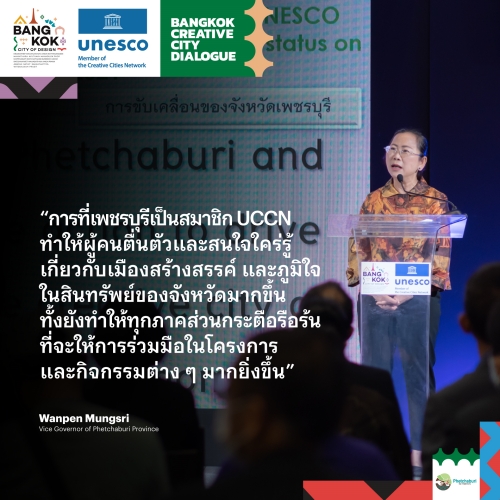
“Phetchaburi is a province famous for its delicious cuisine and was named City of Gastronomy by UNESCO in 2021 (UCCN – Phetchaburi City of Gastronomy). However, we still need to make preparations in many areas, particularly the inclusion of plans to drive creative cities forward into the city’s main strategic plan, strengthening cooperation between all sectors to work together to achieve our common objectives, creating harmonious combinations between food and other aspects of culture through designs to complement each other, and establishing a knowledge-exchange network from both domestic and international experts to drive creative cities in a sustainable manner.
When Phetchaburi was selected as part of the UCCN, the residents were excited and interested in learning more about what creative cities are all about. They, of course, take great pride in the local resources and assets. All sectors are eager to give support for projects and activities, and more, we use design to further promote food and other products, with stories attached to add value and competitive advantage.
All of that has helped promote Phetchaburi travel and tourism, generating benefits for the entire system and not just food-related issues. However, more challenges remain to be overcome in order to ensure sustainable growth and development in Phetchaburi, aiming to become more self-sufficient. Other districts are encouraged to establish their own identities in areas of food and creativity in the future.”
Wanpen Mungsri
Vice Governor of Phetchaburi Province
8. Seoul City of Design (South Korea)
Topic: “For Sustainable Life” by a representative from Seoul City of Design
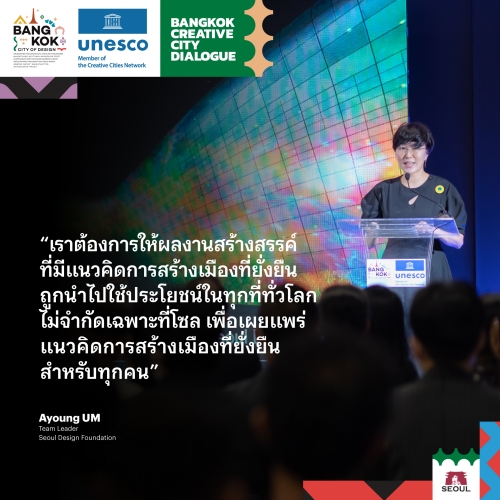
“A good example to actually reflect Seoul as a creative city of design is the Dongdaemun Design Plaza. We were badly affected during the outbreak of COVID-19, and we were looking for ways to prevent the area from being closed and return some lively atmosphere to the place. We decided then to use digital innovation as a supporting tool to organize the Seoul Light Show, which has since 2019 become an important annual event. The Seoul Upcycling Plaza has the main mission of finding ways to recycle and reuse used materials by creating greater awareness and understanding of the problems as a result of waste and garbage, which are everyone’s problem. Plastic recycling will help generate value and is therefore very important. The Seoul Design Incubating Center was established to provide space for young designers to meet and showcase their works, as well as attend necessary training programs to sharpen their skills.
As part of the UCCN – Seoul City of Design, we follow five design principles in order to respond to our intention to promote quality living through design. Those are Empathetic Design, Inclusive Design, Contributive Design, Resilient Design and Sustainable Design. The Seoul Design Award for Sustainable Life is a good example of a campaign that embraces all five principles to help promote the concept of a city for everyone. We anticipate that all the works from this campaign will be used everywhere around the world and not limited to Seoul, so that we can join forces in promoting a sustainable city for every person.”
Ayoung UM
Team Leader
Seoul Design Foundation
9. Singapore City of Design (Singapore)
Topic: “Loveable Singapore Project” by a representative from Singapore City of Design
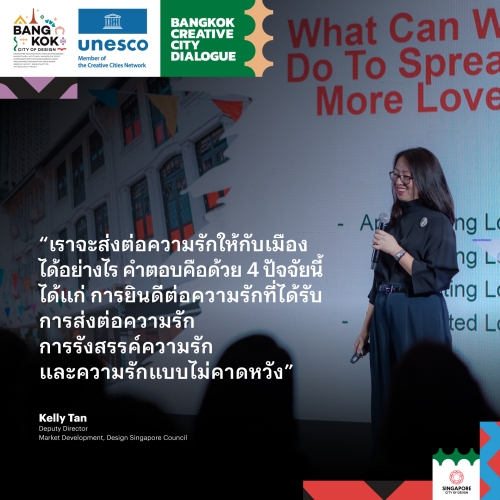
“The Loveable Singapore Project has been implemented for quite some time. We feel that happy citizens are those who can adjust themselves well to changes and live in a city that is also adaptable. When citizens can adjust well, the city will be able to overcome any challenges.
We convey our feelings of love through four factors. First, Appreciating Love where we organized activities for the people, asking them to donate nostalgic items for exhibition in old buildings so that they would recognize the true value of these items. Second, Giving Love is when we organize a workshop for design within the community where everyone can share their thoughts and views on the love they have for the community and what changes they wish to see. Third, Creating Love is reflected through activities organized during the outbreak of COVID-19 for a group of foreign laborers who live together in a small community, helping each other in every possible way. Fourth, Unexpected Love is when we create a happy living environment in areas that have been designed in different ways that are suitable for people of all ages.
In the future. Singapore focuses on promoting greater creativity for the city through projects such as the School of Community Bootcamp, launched as a result of cooperation between different organizations, designers, and stakeholders. They joined together to present ideas and concepts to help solve city problems or promote creativity in one way or another, which in turn helped strengthen relationships between organizations and stakeholders as they had the opportunity to meet directly.”
Kelly Tan
Deputy Director
Market Development, Design Singapore Council
10. Wuhan City of Design (China)
Topic: “Urban Renewal: Old City, New Life” by a representative from Wuhan City of Design
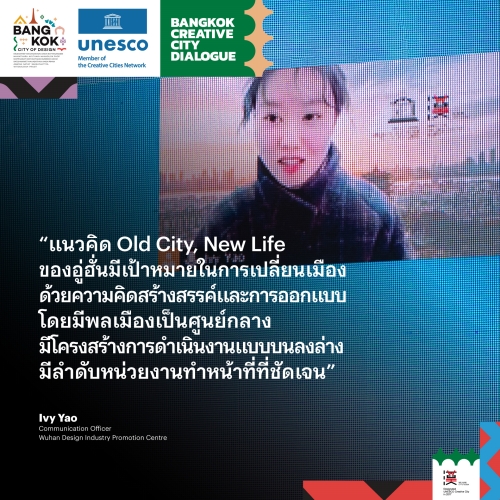
“Wuhan is a very large city in Hubei County, People’s Republic of China, with over 3,500 years of history. In 2017, Wuhan was named the City of Design by UNESCO (UCCN – Wuhan City of Design). Working under the concept of Old City, New Life, Wuhan aims to introduce changes to the city through creativity and design, with its people remaining at the center of these changes. Wuhan adopted a top-down work structure with distinct units of responsibility.
After becoming members of the UCCN, we have established clear plans and policies, placing special emphasis on developing the design industry across the board. We promote the involvement of people from various professions, including fashion, e-sports, animation, music, and food, by having engineering design spearhead the cooperation. The government has also initiated a range of incentive policies to encourage the public to present their projects and gain more involvement. Seminars have been organized for young and talented designers, which attract some 5,000 participants each year. Other on-going activities include meetings and festivals that are organized, such as the Wuhan Design Biennale, which combines design and technology to connect the old and new ways of life together. The event welcomed participants from member countries around the world.
There are also cooperations between cities and countries through exchange programs, seminars, exhibitions, contests, and workshops. We will continue to work on these projects, focusing more on quality, in order to elevate the design industry and develop Wuhan as a creative city with greater identity.”
Ivy Yao
Communication Officer
Wuhan Design Industry Promotion Centre
